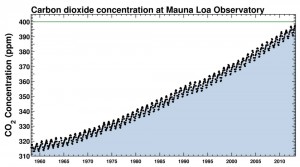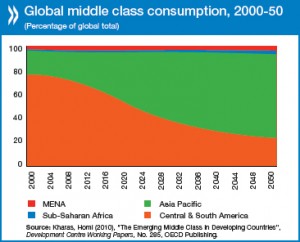400 Parts Per What? and Why You Should Care
May 2nd, 2013 | By admin | Category: Energy and Carbon EmissionsBy Suzanne York, www.howmany.org
At some point in early May, the amount of carbon dioxide (CO2) in the atmosphere is expected to hit 400 parts per million (ppm). It will fluctuate throughout the rest of the year, and for the next several years. It is predicted to stabilize at the 400ppm mark by 2017, and then rise again from there.
It’s no surprise then, that according to the World Meteorological Organization, 2012 was the ninth-warmest year since 1850, and the years 2001-2012 were all among the top 13 warmest on record.
Why should anyone care about 400ppm?
When CO2 levels cross the 400ppm threshold, it will be the first time in human history. Not since the Pliocene Epoch has the Earth experienced such high carbon levels, and during that period the climate was much warmer than it is today.
Jim Butler, director of global monitoring at the Earth System Research Laboratory, part of the National Oceanic and Atmospheric Administration (NOAA), succinctly captured where things stand for people and the planet now:
“This is another global emissions target that we’ve blown past without doing anything. Stronger storms, droughts, rising seas. We are already seeing the impacts of increased CO2 in the atmosphere… How much further can we really go?”
The realization that climate change is resulting in more severe impacts is sinking in for many Americans. A new poll finds 58 percent of Americans link climate change to recent extreme weather.
Yet global climate talks remain stalled and an agreement on reducing emissions isn’t likely until at least 2015.
Population, consumption, and carbon emissions
With mid-range population predictions projecting 9 billion people by 2050, carbon emissions will continue to rise. Yet most of the world’s population growth will occur in Sub-Saharan Africa, where per capita and absolute emissions are low, especially compared to the U.S.; Americans emit 17 tons of carbon per year. Whereas in Africa, 28 of the 55 nations for which data are available have per capita emission rates less than 0.1 metric ton of carbon per person per year (based on 2008 data).
Investing in voluntary family planning, reproductive rights, healthcare, girl’s education, and empowering women are the low-hanging fruit for reaching a stable and healthy population, and also positive ways toward lowering carbon emissions (and improving human rights).
Yet consumption is the bigger factor contributing to emissions, and in many ways it is the more challenging issue. Unsustainable consumption threatens the well-being of people and degrades the environment. As countries develop economically and more of their citizens join the middle class, those emission numbers will grow, and more pressure will be put on natural resources.
The Organisation for Economic Co-Operation and Development (OECD) reported that the size of the global middle class will increase from approximately 2 billion today to nearly 5 billion by 2030. The OECD also noted that sales of refrigerators, television sets, mobile phones, and automobiles have surged in virtually every African country in recent years.
The good news is that just like with population growth, we know what to do, and have the tools to do it now. Getting off fossil fuels and switching to renewable forms of energy are obvious steps to take. Also needed is to support off-grid, distributed energy sources for those who currently lack electricity. Another key element is rethinking economic growth and a shift toward a steady-state, true cost economy.
Technology and innovative ideas will of course play a part but so will living a more sustainable lifestyle – basically having a smaller carbon footprint. The world can continue with business as usual, or it can keep in mind the well-being of future generations. Global society can make things easier and begin now, or procrastinate and make it much more difficult. Before carbon dioxide levels finally pass 400ppm would be a great time to start.
Suzanne York is a senior writer with the Institute for Population Studies


